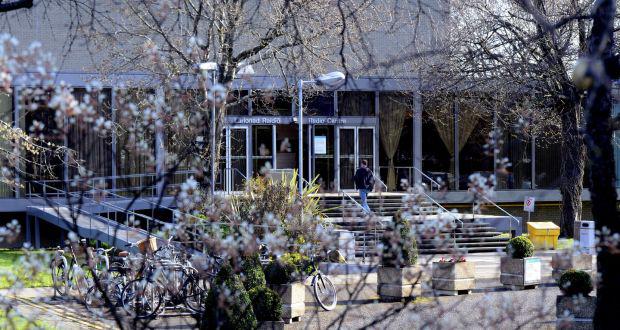|
The RTÉ campus may be a better site for the National Maternity Hospital
By Patsy Mcgarry
Has anyone considered locating the new National Maternity Hospital (NMH) at RTÉ? Space is now available there. It was not last November when the current controversial agreement between the St Vincent’s Healthcare Group and the NMH was concluded. The location is close to the desired adult tertiary hospital at St Vincent’s, in case of a necessity for specialised emergency treatment; while, were it built at RTÉ, the State would remain sole owner of the new NMH and all legal treatments for women would be available without restriction. Last month it was announced that 8.64 acres of RTÉ’s Donnybrook grounds are to be sold off for housing. It also emerged then that the broadcaster was expected to offload up to 15 acres of the 32.12 acre campus it has occupied there since 1961. But it found itself able to sell a smaller land bank because of greatly improved prices for sites due to the economic recovery and an acute shortage of housing in Dublin. Land bankIt means the NMH could be located at RTÉ without disturbing the broadcaster’s plans to sell off those 8.64 acres. The new hospital would need four to five acres at most, it has been estimated, which could come from the remaining RTÉ land bank. The State should, of course, compensate the broadcaster accordingly. It is difficult to see a more satisfactory way out of the impasse over governance and ownership at the proposed maternity hospital on the St Vincent’s campus, particularly when it comes to location. How is handing over ownership of a new NMH to the Sisters of Charity as sole owners compatible with article 44 of the Constitution? But there are deeper questions raised by the current controversy. How is handing over ownership of a new NMH – built by the State at a cost of €300 million – to the Sisters of Charity as sole owners compatible with article 44 of the Constitution? It is quite explicit: “The State guarantees not to endow any religion.” In building and paying for a hospital that is to be run in accordance with the ethos of one particular Christian denomination is the State not endowing religion? Indeed endowing a religion, as none of the other Christian denominations or other faiths holds the same absolute position on human fertility as does the Catholic Church. This was made clear when each made its presentation before the Oireachtas Committee on Health and Children in January 2013, in connection with the then Protection of Life During Pregnancy Bill. Indeed, it might be asked how this was compatible with the then Catholic Archbishop of Dublin John Charles McQuaid’s declaration at the opening of the new St Vincent’s Hospital at Elm Park in 1970 in the presence of the 1937 Constitution architect, President Éamon de Valera? Archbishop McQuaid made it clear that “the same sisters own and manage the new hospital” as did the old St Vincent’s hospital on St Stephen’s Green (referring to the Sisters of Charity). That new hospital too had been built and paid for by the State. In declineMore broadly, what is to happen in Ireland where the Sisters of Charity and other religious congregations involved in State-funded healthcare and education are concerned? All the congregations are in decline with an average age in the early 70s. The average age of Sisters of Charity in Ireland is 76. What is happening now is that lay Catholics are being appointed in their place, some to newly established trusts. Some of these lay appointees hold less nuanced positions on Catholic teaching than the, generally, more theologically informed religious. More fundamentally, perhaps, is to ask why are the religious or their lay appointees so involved in areas that appear remote from what the congregations were set up to do? The Sisters of Charity was founded in Dublin by Mary Aikenhead in 1815 with the aim “to give to people who were poor, what people who had money could buy”, according to its website. The sisters themselves take four vows: “The three vows that most religious orders take, chastity, poverty and obedience, and a fourth vow that is specific to our congregation, ‘service of the poor’.” (None of which apply to their lay appointees). Anyone familiar with the good work of the Sisters of Charity at St Vincent’s or elsewhere could not challenge either their dedication to those vows or the sacrifices they made in service to the suffering or the poor. That is undisputed. ‘Service of the poor’But you do have to wonder why it and similar congregations are involved in running what are now multimillion euro businesses, particularly when it comes to private medicine, which hardly involves “service of the poor”. Another issue for the Sisters of Charity at St Vincent’s is how was it morally compatible for the St Vincent’s Hospital Healthcare Group to use the State-funded St Vincent’s Hospital as collateral for loans needed to build St Vincent’s Private Hospital? Would the St Vincent’s Healthcare Group be tempted to also use the new State-funded €300 million national maternity hospital, which it will own also, as collateral for another adventure down the road? Today these are questions for the healthcare group but they apply also to other religious congregations as they bequeath responsibilities in healthcare and education to private lay Catholic trusts and and where the properties and services involved are funded by the State.
|
.
Any original material on these pages is copyright © BishopAccountability.org 2004. Reproduce freely with attribution.

